National rail operator DSB has announced its 2024 fares after agreement with regional traffic companies and operators Arriva and DOT.
The fares for 2024 were published by DSB on its website on Monday, and will come into effect on January 21st.
“Next year, something will be different about the prices when you travel by public transport,” DSB said on its website.
Prices are being put up next in response to increasing costs, the rail operator said.
The “price regulation” which will take effect next year comes after a “backlog of costs from 2022 and 2023”, it said.
READ ALSO:
- What are the rules for taking your bike on public transport in Denmark?
- EXPLAINED: How to use Copenhagen’s public transport network
- Sporarbejde? The words that will help you navigate public transport in Denmark
The price changes vary between regions and are dependent on the ticket type, but average at around 10 percent.
Many of the higher price changes are in Copenhagen and Zealand, but they also apply in Jutland and Funen.
Travel using the prepaid Rejsekort will cost between 8.75 percent and 12.8 percent more, while the Pendlerkort, the prepay card used by commuters, is up by 5 percent on average in the west of the country compared to 11.2 percent on average for travel east of the Great Belt Bridge.
Single tickets will cost 9.5 percent more although journeys east of the Great Belt Bridge are significantly cheaper in this regard, costing 0.9 percent more than the current price.
A summary of the price changes is as follows:
Rejsekort
- Travel across the Great Belt: Average price increase of between 8.75 and 10 percent
- Travel west of the Great Belt: Average price increase of 11.6 percent
- Travel east of the Great Belt: Average price increase of 12.8 percent
Pendlerkort
- Travel across the Great Belt: Average price increase of 6.2 percent
- Travel west of the Great Belt: Average price increase of 5.0 percent
- Travel east of the Great Belt: Average price increase of 11.2 percent
Single tickets
- Travel across the Great Belt: Average price increase of 9.5 percent
- Travel west of the Great Belt: Average price increase of 7.7 percent
- Travel east of the Great Belt: Average price increase of 0.9 percent
A more thorough description of the price changes including various discount cards for students and pensioners can be found on DSB’s website.
Travel between the eastern and western parts of Denmark over the Great Belt Bridge will see the steepest of the prices rises, but DSB customers will still be able to make savings by purchasing Orange tickets, the limited number of reduced-price tickets for set departure times made available by DSB.
“If you can travel outside of peak times, there are still very good opportunities to find a good offer,” DSB’s head of customer services Charlotte Kjærulff told news wire Ritzau.
For example, Orange tickets from Aarhus to Copenhagen can be purchased from 119 kroner, almost a quarter of the regular single-ticket price, which is 469 kroner.
The Danish Civil Aviation and Railway Authority (Trafikstyrelsen) has input into DSB’s prices.
The government agency decides the limits by which public transport fares may be put up. Costs at operators are taken into account.
Recent years have seen transport operators face increasing energy costs and inflation.
DSB has not raised prices to the full limit set by the travel authority, with the average price increase across the country not amounting to the 2024 limit of 10.3 percent set by the Danish Civil Aviation and Railway Authority.



 Please whitelist us to continue reading.
Please whitelist us to continue reading.
Member comments